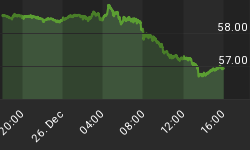While Thursday's gains in stocks appear to be impressive, they do little in terms of making an impact on longer-term trends. We do not need any complicated technical indicators to discern the long-term trends on the following charts. Thursday's rally in stocks cannot even be seen on the six-year chart of the S&P 500 Index below.

Similarly, the 1.00% move to the upside in foreign stocks as of Thursday morning has no impact on the primary trend, which remains down. If an investment is aligned with a primary trend, it can be treated as a buy-and-hold position as long as you also factor in principal protection when necessary. You should be able to look at a chart and ask, "Am I aligned with the trend?" If the answer is yes, you will never go too far wrong in the long run.

Financial stocks, shown below, could move quite a bit higher without doing any damage to the primary trend, which remains firmly down.

While a little late to the party, emerging market stocks (below) have seen their 200-day moving average recently turn over (see red line), which is bearish.

The NASDAQ has held up relatively well since stocks peaked in October of last year, which means it has lost less than your average stock index. As the basic downward trend channel illustrates below, this may mean the NASDAQ has more downside risk should the current trend hold.

Commercial real estate (below) has done nothing yet to indicate any basis for optimism.

The jury is still out on the U.S. dollar's recent attempt to reverse a long-term downtrend. The move cannot be ignored, but a resumption of the downtrend is still a very real possibility.

Gold, like the dollar, could go either way in the intermediate term. If we are patient better information will surface.

Gold mining stocks have suffered more technical damage than the dollar. Therefore, a little more patience should be exercised when deciding on current allocations.

Commodity stocks (heavy energy weight) are in a similar boat to gold mining stocks.

The bond market is not forecasting better times ahead. The chart below shows the ratio of long-term U.S. Treasury bonds to investment-grade U.S. corporate bonds. The reason for looking at this ratio is quite simple. When investors feel more confident about future economic activity, they are more willing to take on the added risk associated with corporate bonds to earn a more favorable return. Conversely, when investors feel less confident about the future, they will favor the safe haven and lower returns available in Treasuries. Notice in the chart below, this ratio did a good job of reacting to the onset of the current credit crisis in July of 2007.

Fundamentals Still A Concern
On a positive note, we did get an impressive revision to GDP (economic activity) this morning, which is behind today's stock rally. The primary drivers behind the strong GDP readings were exports and the stimulus checks from Uncle Sam.
From an August 28, 2008 Bloomberg article:
"The U.S. economy expanded faster than previously estimated in the second quarter, helped by a surge in exports that will probably wane as Europe and Japan head toward recessions."
"The expansion is likely to weaken in the second half as consumers burdened with falling home values and dwindling job prospects rein in spending. Separate figures today showed the number of Americans collecting unemployment benefits reached a five-year high last week."
From an August 28, 2008 MarketWatch article:
"U.S. economic growth in the second quarter was much stronger than previously believed, but it could represent the high-water mark for the economy for at least the next year."
"Weak banks, exhausted consumers and cautious hiring are expected to drag down growth in coming quarters. And with no end in sight for the drop in house prices, economists are unable to see an end to the financial-market stress that is holding back activity."
Housing data released earlier this week still shows more than a ten month supply of unsold homes on the market, and not surprisingly more declines in home values. Until inventory gets in the six to seven month range, it is not realistic to call a bottom in home prices. Falling home prices mean more problems for banks.
As we know, many financial firms are looking for capital to stop the erosion of their balance sheets. Banks and brokerage firms have to pay off $95 billion in floating rate notes when they mature in the next thirty days. It is estimated the total amount coming due between now and the end of 2009 is $787 billion, which represents a 43% increase in what they had to pay off in the last 16 months (source: Wall Street Journal, 8/27/2008).
Fundamentals and Technicals Are Aligned
Unfortunately, they remain aligned in negative territory. Great opportunities, instead of false rallies, lie ahead for investors who remain focused on the big picture rather than the day-to-day swings in asset prices. When we have ample evidence which merits a more positive outlook, it will be easy to illustrate on the charts. Good things come to those who wait.
















